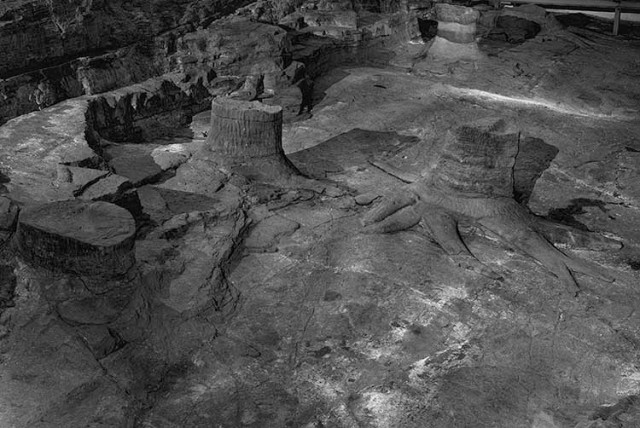The Fossil Grove, situated in Victoria Park, Glasgow contains tree stumps that are the remains of an ancient forest, from around 330 million years old. Fossil Grove is one of the most famous in-situ Carboniferous forest examples in the world.
The fossilised tree stumps were discovered in 1887 when an old quarry was being landscaped as part of the work during the creation of the park, and the fossil trees were uncovered by removal of the surrounding rocks. Careful excavation of the site uncovered the fossil remains, and a building was erected to protect them from the elements. Today at the Fossil Grove, you will see a small corner of a vast ancient forest, preserved in stone.
The most obvious feature of the site is the 11 fossil tree stumps, some of them up to 90 centimetres high. They are preserved in the position in which they once grew. A fallen trunk, about eight metres long, and other smaller fragments of branch and root, have also survived. They are the fossil remains of an extinct type of plant known as a giant clubmoss (Lepidodendron).
When these trees were alive, Glasgow’s climate was hot, damp and steamy. The trees grew in a tropical swamp similar to today’s Florida Everglades. After the clubmoss trees died, their interiors rotted, leaving them hollow. Gradually sand and mud carried by huge rivers buried the tree stumps and the sediment around then completely enclosed them, eventually turning into sandstone. Millions of years later, molten lava from volcanoes was forced between these sandstone layers. The lava cooled and formed whinstone, and this hard rock layer protected the fossil trees from erosion.
Scottish Natural Heritage has designated the grove a site of Special Scientific Interest, and it is also designated as a Regionally Important Geological / Geomorphological Site.
In addition to the importance of the fossilised stumps, the building itself is important because not only is the Fossil grove one of the world’s oldest examples of conservation of a geological site, it was the first to be preserved by a building. A viewing balcony overlooks the fossils, and small displays provide information and interpret the site for visitors.
Related articles
- Kelvingrove Art Gallery and Museum (mikehardisty.wordpress.com)
- Weekly Photo Challenge: Hidden (fromundermanyhats.com)
- Weekly Photo Challenge: Hidden (directionallyimpaired.wordpress.com)
- Weekly Photo Challenge: Hidden (andreadreamin.com)
- Weekly Photo Challenge: Hidden (dailypost.wordpress.com)
- Weekly Photo Challenge: Hidden (thebloggingpath.com)
- Weekly Photo Challenge: Hidden (maggiephotgraphy.wordpress.com)
- Weekly Photo Challenge: Hidden (hereandthere5.wordpress.com)

wow, what an amazing place. Like taking a step back in time. awesome 🙂
LikeLike
Brenda, thank you for your comment. When I was a kid I used to live about 5 minutes walk away from the Fossil Grove which is in a public park. I used to love visiting there as it just fascinated me.
LikeLike
Mike, good to see you back – did miss you last week! Amazing to think this fossil grove exists in lovely Glasgow but how exciting and fabulous to know this ancient history still exists within our midsts.
LikeLike
Thanks Patti. It’s been a busy two weeks. First of all I had the photo get together, which I had organised, on Anglesey and then Caernarfon. in North Wales. I took over 400 hundred photographs which had to be catalogued and rated (my own personal choice) and then the best ones chosen for the blog. Then it was back to the beta testing of some photography software and finally decorating which I’ve only just finished. In the meantime I also bought myself a new camera, just a pocket one that I can use for urban shooting, the DSLR attracts too much unwanted attention these days…..
LikeLike
Absolutely amazing. I would love to see it in person. I like the black & white photo too.
LikeLike
If you ever decide to visit Scotland from the US of A and had time to see these wonderful trees, check the opening times. Used to be they were open from dawn to dusk almost every day of the year. Now you are only able to visit them during the summer months
LikeLike
so fascinating – thanks for sharing.
LikeLike
Thank You for your comment…..
LikeLike
They look like they were hidden for many years.
LikeLike
They sure were, Shame they are going to be hidden now, but thank you for your comment
LikeLike
very fossil!
LikeLike
Yes, they are….
LikeLike
thanks for your link at
LikeLike
Hi Mike..Very Jurassic Park!! Interesting place indeed. Thanks for this.
Cheers
LikeLike
Wow that is so amazing! Thanks for sharing 🙂
LikeLike
A different view for my eyes. Thanks for sharing! This is amazing. 🙂
LikeLike
thanks for posting this…I may never reach this place physically but at least I get to admire the beauty of this grove.
LikeLike
that is verrrry goood!!
LikeLike
a great hidden treasure, I am always amazed at petrified wood and stumps in this case. Beautiful and strange world we live in.
LikeLike
really beautiful shot! and taking it in B&W makes it all the more interesting!
LikeLike
It’s a while since I visited, and I’d forgotten all about it. Thanks fofr reminding me
LikeLike
Love this – kept me intrigued for ages
LikeLike
Wow…fossilized tree stumps! I have never seen one and seeing them on this post is totally awesome. The black and white effect increased its depth and quality. Beautiful!
LikeLike
Great post about this fossils tree of 18 century thanks for sharing
LikeLike
It looks like somewhere in indiana jones movie 🙂 great shot!
LikeLike
very cool!
LikeLike
Fascinating post – I thoroughly enjoyed reading it. 🙂 Nice shot of the fossils in (I suspect) not ideal photographic circumstances too!
LikeLike
what a fascinating place – makes me want to jump on a plane and head to Scotland to see it. Thanks for sharing it.
LikeLike